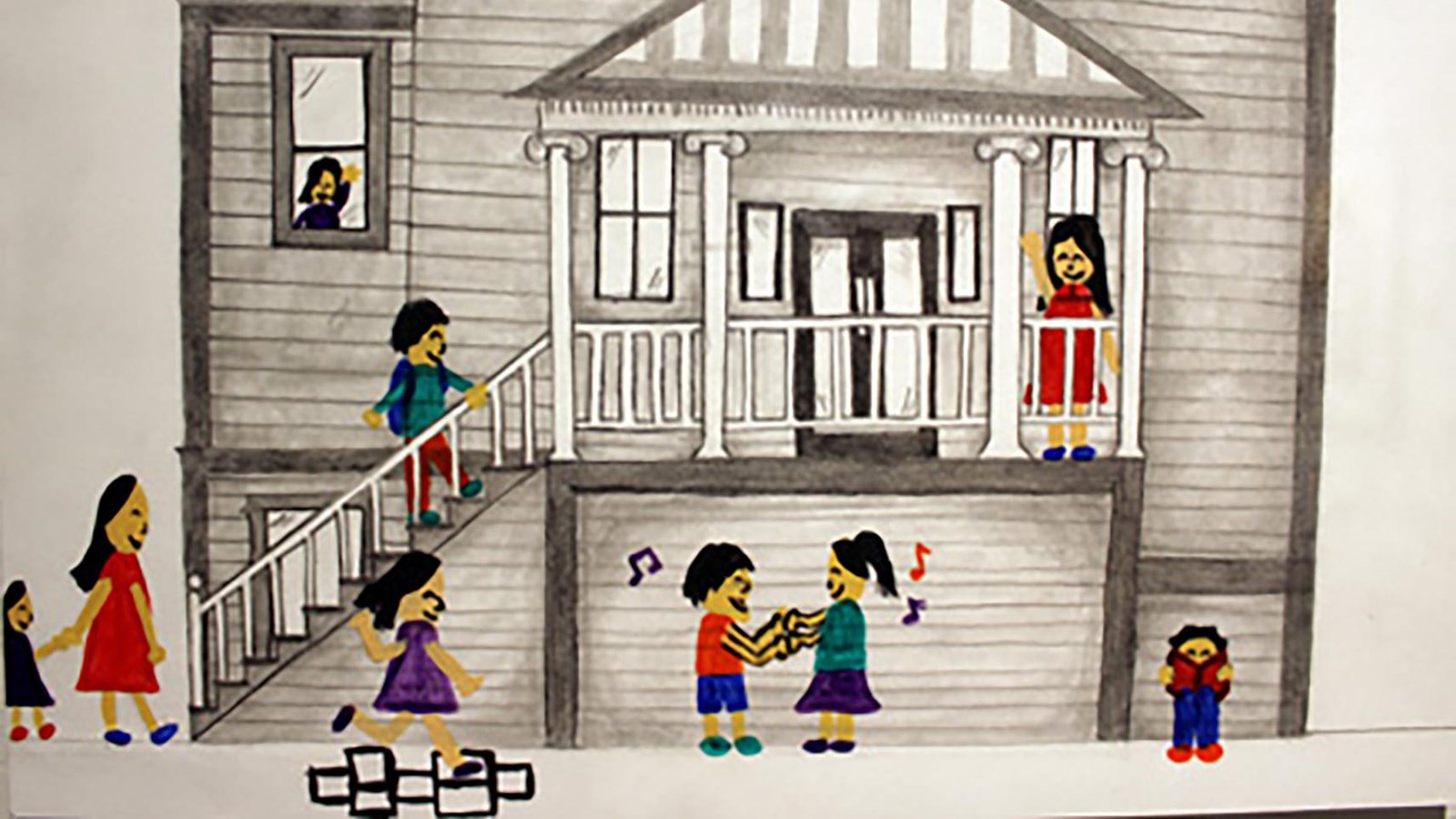Last updated: March 12, 2025
Place
Main Street School Annex (#13)

By artist Emelyn Sung. YouthCAN, Wing Luke Museum.
Quick Facts
Location:
307 6th Ave S
Significance:
Also known as: H.T. Kubota Building
Mile: 0.34
As the Japanese immigrant population began to swell on the American mainland from 2,039 in 1890 to 72,157 in 1910, so did resentment and racial prejudice from White America, which saw the Japanese as economic competition. The U.S. and Japanese governments entered into the Gentlemen’s Agreement in 1908; Japan agreed to halt the immigration of its laborers. In the Ladies’ Agreement with the U.S. government in 1921, Japan ended the immigration of “picture brides.”
Despite exclusionary immigration laws that limited the growth of families, some Japanese American children still grew up in Japantown. This two-room school building (annex to the original 1873 Main Street School) was opened in 1902 and served as Seattle’s first place to teach kindergarten children. The school especially served second generation Japanese and Chinese American children from Japantown and nearby Chinatown.
Its most notable event is associated with the school’s closing. Too small for a growing population, students – led by Principal Ada Mahon – lined up outside on a rainy day on December 21, 1921 to parade up Jackson Street to their new elementary school, Bailey Gatzert, then located up the hill at 12th and Weller.
Ada Mahon (1875-1951) taught at Denny and Horace Mann Schools before serving as the vice-principal of Main Street School in 1910. She later became principal of Main Street School and then Bailey Gatzert Elementary School, both of which had mainly Japanese American students in various years. For the 1920-21 school year, 334 out of 445 students at the Main Street School were Japanese American. In 1926, Bailey Gatzert’s students included 741 Japanese American, 63 Chinese American, 2 Filipino American, 5 African American and 19 White students.
Much beloved and highly regarded, many especially remember Mahon for her response to students after the attack on Pearl Harbor in December 1941, “You were American citizens last Friday; you are American citizens today. You were friends last Friday; you are friends today." With the forced removal of Japanese Americans from Seattle in spring 1942, she held assemblies so the Nisei (second generation Japanese American) students could say goodbye to their classmates.
The original brick entryway to Bailey Gatzert Elementary School is preserved at the Seattle Indian Health Board, located at 611 12th Avenue South. As you move from waypoints #32 and 33 on the Japanese American Remembrance Trail, the building is located on the southwest corner of 12th and Weller.
As the Japanese immigrant population began to swell on the American mainland from 2,039 in 1890 to 72,157 in 1910, so did resentment and racial prejudice from White America, which saw the Japanese as economic competition. The U.S. and Japanese governments entered into the Gentlemen’s Agreement in 1908; Japan agreed to halt the immigration of its laborers. In the Ladies’ Agreement with the U.S. government in 1921, Japan ended the immigration of “picture brides.”
Despite exclusionary immigration laws that limited the growth of families, some Japanese American children still grew up in Japantown. This two-room school building (annex to the original 1873 Main Street School) was opened in 1902 and served as Seattle’s first place to teach kindergarten children. The school especially served second generation Japanese and Chinese American children from Japantown and nearby Chinatown.
Its most notable event is associated with the school’s closing. Too small for a growing population, students – led by Principal Ada Mahon – lined up outside on a rainy day on December 21, 1921 to parade up Jackson Street to their new elementary school, Bailey Gatzert, then located up the hill at 12th and Weller.
Ada Mahon (1875-1951) taught at Denny and Horace Mann Schools before serving as the vice-principal of Main Street School in 1910. She later became principal of Main Street School and then Bailey Gatzert Elementary School, both of which had mainly Japanese American students in various years. For the 1920-21 school year, 334 out of 445 students at the Main Street School were Japanese American. In 1926, Bailey Gatzert’s students included 741 Japanese American, 63 Chinese American, 2 Filipino American, 5 African American and 19 White students.
Much beloved and highly regarded, many especially remember Mahon for her response to students after the attack on Pearl Harbor in December 1941, “You were American citizens last Friday; you are American citizens today. You were friends last Friday; you are friends today." With the forced removal of Japanese Americans from Seattle in spring 1942, she held assemblies so the Nisei (second generation Japanese American) students could say goodbye to their classmates.
The original brick entryway to Bailey Gatzert Elementary School is preserved at the Seattle Indian Health Board, located at 611 12th Avenue South. As you move from waypoints #32 and 33 on the Japanese American Remembrance Trail, the building is located on the southwest corner of 12th and Weller.
